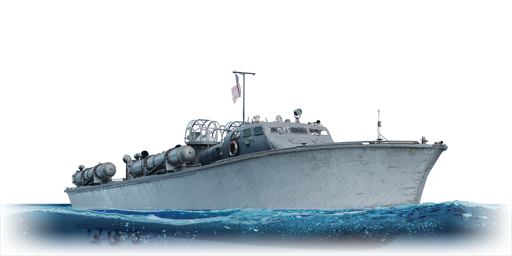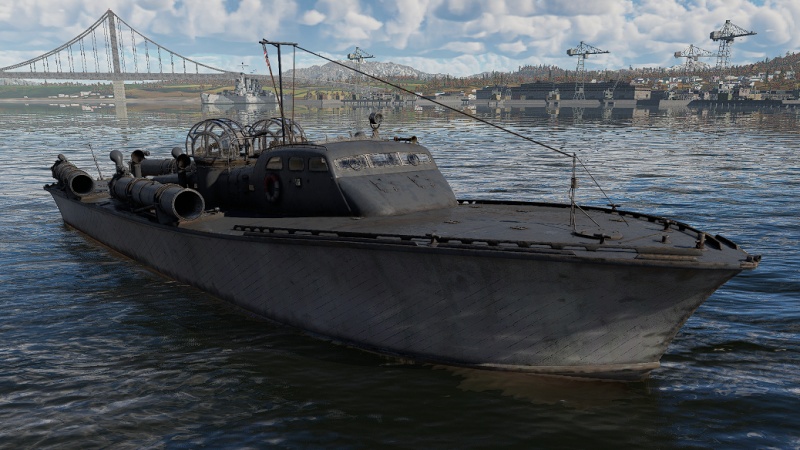PT-20
Contents
Description
The Elco 77 ft PT-20 is a rank American motor torpedo boat with a battle rating of (AB), (RB), and (SB). It was introduced in Update 1.79 "Project X" as part of the fleet closed beta test.
General info
Survivability and armour
The PT-20 has no areas with serious amounts of armour protection. The hull of the vessel consists of 40 mm thick ship wood and the bridge on top is made of 15 mm ship wood. Any projectile that hits will penetrate and deal damage, including fragmentation and splash damage from nearby shells. The crew is 15 people, which is about average for the PT-20's BR, although any prolonged engagement will likely end in destruction through the loss of the crew. The PT-20 has a total of 4 compartments, 3 for the hull and one for the bridge. The second section of the hull houses the fuel tanks, and the third contains the three engines. Damage to the middle of the ship will often set fires or disable the mobility of the PT-20.
Mobility
The PT-20 is a very quick and agile vessel and is able to reach its top speed in under 15 seconds from a stopped position. A 180° turn can be performed in about 10 seconds when started at full speed, and a complete loop can be made in under 20 seconds. Half rudder deflection is achieved in 2 seconds and maximum deflection in around 10 seconds.
| Mobility Characteristics | |||
|---|---|---|---|
| Game Mode | Upgrade Status | Maximum Speed (km/h) | |
| Forward | Reverse | ||
| AB | |||
| Upgraded | |||
| RB/SB | |||
| Upgraded | |||
Modifications and economy
Armament
Primary armament
| 12.7 mm AN-M2 (x4) | ||||||
|---|---|---|---|---|---|---|
| 2 turrets | ||||||
| Port Turret | Starboard Turret | |||||
| Vertical guidance | -5°/+65° | -5°/+65° | ||||
| Horizontal guidance | ±180° | ±180° | ||||
| Ammo capacity | 9,600 | |||||
| Rounds per turret | 4,800 | |||||
Important to note is the fact that the main armament is unable to aim at targets on the water directly ahead due to the turrets being located just behind the bridge. Off to the side of the vessel, it is possible to aim one or both of the turrets and directly astern it is possible to use both.
Ammunition
- Universal: API-T · AP · I · AP
- .50 AP belt: API-T · AP · AP · AP
- .50 APIT belt: API-T · API-T · API-T · I
| Penetration statistics | |||||||||
|---|---|---|---|---|---|---|---|---|---|
| Shell | Type of warhead |
Penetration @ 0° Angle of Attack (mm) | |||||||
| 10 m | 100 m | 500 m | 1,000 m | 1,500 m | 2,000 m | ||||
| M20 | API-T | 28 | 27 | 23 | 19 | 15 | 12 | ||
| M2 | AP | 29 | 28 | 25 | 20 | 17 | 14 | ||
| M1 | I | 2 | 2 | 2 | 2 | 2 | 2 | ||
| Shell details | |||||||||
|---|---|---|---|---|---|---|---|---|---|
| Ammunition | Type of warhead |
Velocity (m/s) |
Projectile mass (g) |
Fuse delay (m) |
Fuse sensitivity (mm) |
Explosive mass (TNT equivalent) (g) |
Ricochet | ||
| 0% | 50% | 100% | |||||||
| M20 | API-T | 887 | 40 | N/A | N/A | N/A | 47° | 56° | 65° |
| M2 | AP | 856 | 50 | N/A | N/A | N/A | 47° | 56° | 65° |
| M1 | I | 944 | 40 | 0.02 | 0.3 | 1.2 | 47° | 56° | 65° |
Additional armament
| 533 mm Mk.8-3 C/D torpedo | ||||||||
|---|---|---|---|---|---|---|---|---|
| # on ship | Mass (kg) | Maximum speed in water (km/h) |
Travel distance (km) | Depth stroke (m) | Arming distance (m) |
Explosive type | Explosive mass (kg of TNT equivalent) | |
| 4 | 1379 | 54 | 3.65 | 1.0 | 50 | Torpex | 435 | |
Usage in battles
This boat is difficult to play. The optimal position to maximize your survivability is to have your bow pointing directly at your enemy, however that also means you have no guns to fire at them. The optimal position for your guns is to have your rear point at the enemy, but it exposes 3 of the 4 sections of the boat(particularly when driving forward at a high speed).
It is recommended you engage enemies by driving directly at them, releasing your torpedoes, then do a 180 and either use your machine guns to fight or smokes to run away.
Other players that prefer to play less aggressively just play the boat constantly in reverse, so they can always have guns to fire 'forwards'. Another variant of this playstyle is camping behind an island with all four guns pointed at a high traffic area.
Some players attempt to play the boat as an AA gun, but it lacks the vertical elevation to engage planes directly above it and the survivability to take on strafing fighters.
Pros and cons
Pros:
- .50 calibre machine guns can effectively deal with just about any opponent it faces
- The 21-inch torpedoes can instantly obliterate an enemy ship, given they hit their mark
- Decent top speed and acceleration
Cons:
- .50 cal turrets cannot face forward
- The arrangement of the torpedoes requires firing from an angle against an enemy
- Wooden ship with no armour
History
The 77 ft PT-20 was a follow-on to the first serial production PT boats in the United States, the Elco 70 ft PT-10 series. The PT-20 series were longer and heavier than their predecessors, which caused a reduction in speed, although they were given additional torpedo tubes in an effort to increase the firepower. The change to 21 inch (53.3 cm) torpedo tubes up from 18 inch (45.7 cm) was a large addition to weight, and the earlier 70 ft PT boats could not carry the desired amount of torpedo tubes. In late 1941 and early 1942 a total of around 50 of these 77 ft Elco PT boats were produced and these would form the basis for the other widely produced versions such as the Elco 80 ft PT-103.
The ship was laid down on October 14, 1940 by the Electric Boat Co., Elco Works, in Bayonne, New Jersey. It was launched on March 14, 1940, and was completed on June 9, 1941.
It was commissioned on June 20, 1941, and was assigned to Motor Torpedo Boat Squadron TWO (MTBRon 2), as the USS PT-20. MTBRon 2, under the command of Lt. Comdr. Earl S. Caldwell, USN, tested the first 70 ft Elco boats between 1940 and 1941, in the Caribbean. In December 1941 the squadron received eleven new 77 ft Elco boats, and was moved to the Panama Sea Frontier. On August 13, 1941 the PT-20 was transferred to Motor Torpedo Boat Squadron ONE (MTBRon 1). MTBRon 1, under the command of Lt. William C. Specht, USN, was the first squadron of its kind commissioned, and was originally used for the testing of experimental boats. It was later moved to Hawaii, and it was composed of 77 ft Elco boats. It participated in the Battle of Midway and the Aleutian Campaign.
The USS PT-20 was struck from the Naval Register on December 22, 1944. It is unknown what happened to the ship afterwards.
It had a displacement of 40 t, a length of 77 ft, a beam of 19 ft 11 in, and a draft of 4 ft 6 in. It was powered by three 1,500 shp Packard V12 M2500 gasoline engines, and it had three shafts.The armament consisted of two twin .50 cal. Browning M2 machine guns in Dewandre turrets, two .303 cal Lewis machine guns and four 21" torpedoes. The crew complement was 15 sailors and officers, and the ship had a maximum speed of 41 knots.
Media
- Skins
- Videos
See also
- PT-103: Elco's successor to the 77 ft PT-20 series, and one of the most widely produced versions of the PT boats in World War II
External links
References
- Bibliography
- Radigan, Joseph M. PT-20. NavSource Naval History. http://www.navsource.org/archives/12/05020.htm
| Electric Launch Company (Elco) Ships | |
|---|---|
| Patrol Torpedo Boats (PT) | |
| 77' PT | PT-20 · PT-59 |
| 80' PT | PT-103 · PT-109 · PT-174 · PT-314 · Thunderbolt (PT-556) · PT-565 |
| USA boats | |
|---|---|
| Motor torpedo boats | PT-3 · PT-6 · PT-20 · PT-71 · PT-103 · PT-109 · PT-174 |
| PT-200 · PT-314 · Thunderbolt (PT-556) · PT-565 · PT-658 · PT-810 · PT-811 · PT-812 | |
| Motor gun boats | Kim Qui · LCS(L)(3) · PT-59 · PTF-7 · USS Candid · USS Asheville · USS Douglas · USS Flagstaff · USS Tucumcari · USS Cyclone |
| Armoured gun boats | LCM(6) Zippo |





